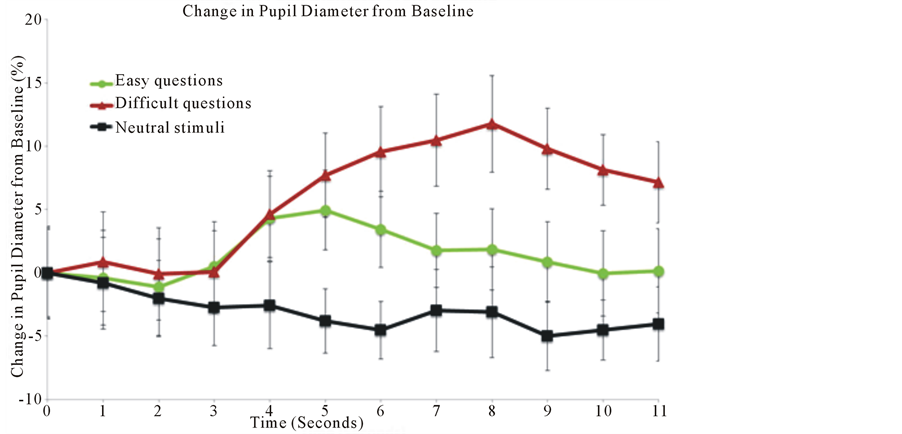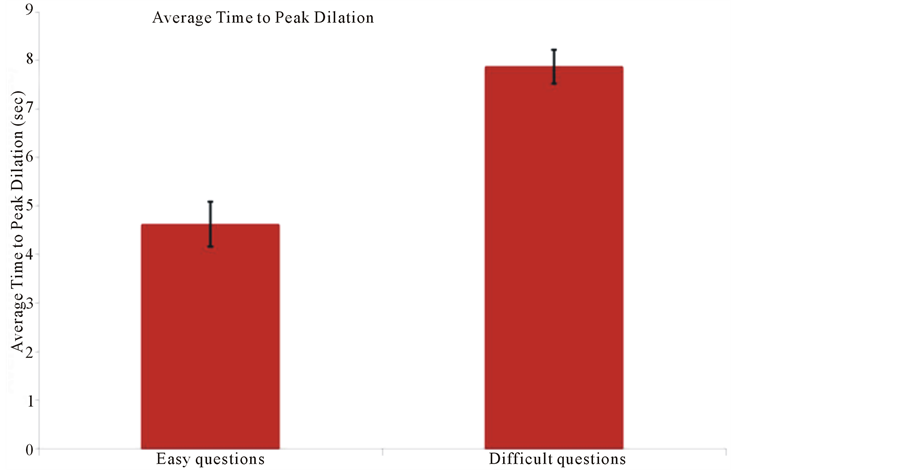Open Journal of Emergency Medicine
Vol.2 No.1(2014), Article ID:44422,4 pages DOI:10.4236/ojem.2014.21002
Increasing Pupil Size Is Associated with Increasing Cognitive Processing Demands: A Pilot Study Using a Mobile Eye-Tracking Device
Adam Szulewski1, Shannon M. Fernando2, Jared Baylis2, Daniel Howes3,4
1Department of Emergency Medicine, Queen’s University, Empire 3—Kingston General Hospital, Kingston, Canada
2School of Medicine, Queen’s University, Kingston, Ontario, Canada
3Kingston Resuscitation Institute, Kingston, Canada
4Department of Emergency Medicine and Critical Care Program, Queen’s University, Kingston, Canada
Email: aszulewski@qmed.ca, howesd@kgh.kari.net
Copyright © 2014 by authors and Scientific Research Publishing Inc.
This work is licensed under the Creative Commons Attribution International License (CC BY).
http://creativecommons.org/licenses/by/4.0/


Received 12 January 2014; revised 7 February 2014; accepted 10 March 2014
ABSTRACT
Previous studies have shown that increases in pupil size are correlated with increasing cognitive processing demands. Our aim was to confirm whether these findings could be replicated with new portable and less obtrusive eye-tracking technology. We assessed the percentage change of pupillary diameter from baseline as eight subjects completed a series of randomly ordered arithmetic problems of varying difficulty. The mean peak pupil diameter expressed as a percentage change from baseline was significantly greater when answering difficult questions compared to easier questions. Moreover, the time to reach peak pupillary diameter occurred significantly faster when participants answered easier questions compared to more difficult questions. Finally, there was a significant difference when all groups were compared to control. This experiment confirms findings of previous studies that show that pupillary size is related to cognitive processing demands. It also demonstrates that mobile eye-trackers can be used to reliably gather this type of data. Furthermore, this experiment provides the basis for future studies using eye-tracking technology in new environments, for example in the study of expertise and performance in medical crisis situations.
Keywords:Cognitive Load; Eye-Tracking; Gaze-Tracking; Medical Education

1. Introduction
Increases in pupil size have been shown to correlate with increasing cognitive processing demands. These increases in pupil size occur shortly after the onset of the processing of a task and subside quickly once processing is terminated. Most importantly, the magnitude of pupillary dilation has been shown to be related to the cognitive processing load (or mental effort) needed to complete a particular mental task. Furthermore, it has been shown that task-evoked pupillary size changes are analogous to task-evoked brain potentials measured by electroencephalography [1] .
Mental arithmetic problems have been used in previous work to study cognitive processing demands using pupillometry [2] . Hess and Polt showed that from the time of problem presentation to solution, pupillary diameter increased consistently in all subjects.
Moreover, it has been shown that pupillary diameter increases to a greater degree and the latency to peak size is greater when solving difficult problems [3] .
Similar changes in pupil size have been found in spelling, where maximum pupil size is correlated to the difficulty of the word as well as in the solving of anagrams [4] .
The aim of our study was to confirm whether we could use a mobile eye-tracking device to replicate the findings of previous experiments which show that changes in pupil size are related to cognitive processing load. The portability and ease of use of such a mobile eye-tracking device could be advantageous in a variety of realworld educational applications.
2. Methods
Nine participants, each with a minimum of an undergraduate university degree, were asked to answer arithmetic problems that were presented on a screen while wearing the Tobii Glasses Eye Tracker device. The device consists of a belt-pack connected to a pair of eye-glasses that contain cameras that are able to record a first-person view of the subjects’ surroundings, dynamic pupil position data and relative pupil size [5] . Each participant was calibrated prior to the experiment and then sat at a distance of one metre from a computer screen while a slideshow with the math problems played. The slideshow consisted of 15 multiplication problems consisting of two multiplicands. Eight easy questions in the range of (6 to 9) × (10 to 14) and seven difficult questions in the range of (11 to 15) × (16 to 19) were presented (see Figure 1).
Each problem was presented for a total of 5 seconds after which time a black circle was shown for 10 seconds. Another problem would then follow. Periodically, a slide was presented with a black star instead of an arithmetic problem that was designed to evoke a return to baseline cognitive load; this served as the neutral stimulus. Participants were asked to concentrate their gaze at the centre of the screen at all times and focus on either the equation, the black dot or the black star that was presented in an effort to minimize the pupillary accommodation reflex. Participants were asked to verbalize answers to the problems as they arose.
Pupil diameter data, expressed as the percentage change from baseline at calibration, was exported into a spreadsheet for each participant. One of our participants’ data was excluded in its entirety due a lack of complete data, possibly from excessive blinking. In addition, the first question of each set of problems was excluded from the analysis as it was considered to be an establishment of baseline.
Data points at 30 Hz were averaged for each participant to determine a pupillary size reading for each second. These data points were then averaged for all eight included participants to give a composite mean value for each second. These last values were then grouped to show pupil size change from baseline for easy questions, difficult questions and neutral stimuli.
The study protocol was approved by the Queen’s University Health Sciences Research Ethics Board.
 (a)
(a) (b)
(b)
Figure 1. (a) (a) Example of a “difficult” problem; (b) Example of an “easy” problem.
3. Results
Change in pupil diameter for difficult questions, easy questions, and neutral stimuli, expressed as a percentage compared to baseline at calibration, was recorded (Figure 2). It was found that significant differences between the “Difficult” and “Easy” questions emerged 3 seconds after the stimulus had been presented. The difference between these two groups persisted for at least 4 seconds after the stimulus had been removed. “Difficult” questions resulted in a peak dilation of +11.8% compared to baseline whereas “Easy” questions resulted in a peak dilation of +5.0% compared to baseline (post-hoc Tukey-Kramer test p-value 0.005). Both “Difficult” and “Easy” questions produced more peak dilation than neutral stimuli (post-hoc Tukey-Kramer test p-values <0.001 and 0.002 respectively).
To further quantify the response to stimuli, we measured the latency to peak dilation for the “Easy” and “Difficult” questions (Figure 3). It was found that the mean peak response for “Difficult” questions occurred at 7.9 seconds which was significantly later than that for “Easy” questions at 4.6 seconds (post-hoc Tukey-Kramer test p-value 0.007).
4. Discussion
This experiment confirms findings of previous studies that show that pupillary size is related to cognitive processing demands. We have shown consistency with previous work that indicates that peak pupillary size is larger and the time to reach peak pupillary size is greater with more taxing mental arithmetic problems [3] . Moreover, we found that the use of a mobile eye-tracking unit like the Tobii Glasses Eye Tracker is a reliable and efficient method of gathering pupil size data in real time.
5. Conclusion
This study provides a basis for future experiments to study cognitive load and processing demands in a variety of settings. Pupillometry and gaze-tracking technology give the researcher a quantitative means to measure mental processing demands easily. We plan to build on the results of this experiment to study cognitive load in doctors and doctors-in-training during simulated medical crisis situations. We would like to characterize the differences in cognitive load as well as pupil fixation behaviours between novice physicians and expert physicians

Figure 2. “Difficult” questions resulted in peak dilation of 11.8% compared to baseline whereas “Easy” questions resulted in peak dilation of 5.0% compared to baseline (posthoc Tukey-Kramer test, p-value 0.005). Time 0 to 3 seconds serves as baseline (3 seconds prior to question presentation); time 3 to 8 seconds corresponds to the time that the question was on the screen; time 8 to 11 seconds corresponds to the 3 seconds after the question was removed and the black dot appeared.

Figure 3. It was found that the mean peak response for “Difficult” questions occurred at 7.9 seconds which was significantly later than that for “Easy” questions at 4.6 seconds (post-hoc Tukey-Kramer test p-value 0.007).
in these circumstances. The results of these studies will be relevant in the medical education realm where cognitive demands on learners are of paramount importance. Furthermore, our aim is to eventually assess the validity of using expert behaviours identified with the eye-tracker as a component of evaluation in both undergraduate and postgraduate medical training.
References
- Beatty, J. (1982) Task-Evoked Pupillary Responses, Processing Load, and the Structure of Processing Resources. Psychological Bulletin, 91, 276-292. http://dx.doi.org/10.1037/0033-2909.91.2.276
- Hess, E.H. and Polt, J.M. (1964) Pupil Size in Relation to Mental Activity during Simple Problem Solving. Science, 140, 1190-1192. http://dx.doi.org/10.1126/science.143.3611.1190
- Ahern, S. and Beatty, J. (1979) Pupillary Responses during Information Processing Vary with Scholastic Aptitude Test Scores. Science, 205, 1289-1292. http://dx.doi.org/10.1126/science.472746
- Hess, E.H. (1965) Attitude and Pupil Size. Scientific American, 212, 46-54. http://dx.doi.org/10.1038/scientificamerican0465-46
- Tobii Technology (2013) Mobile Eye Tracking. http://www.tobii.com/en/eye-tracking-research/global/products/hardware/tobii-glasses-eye-tracker/

